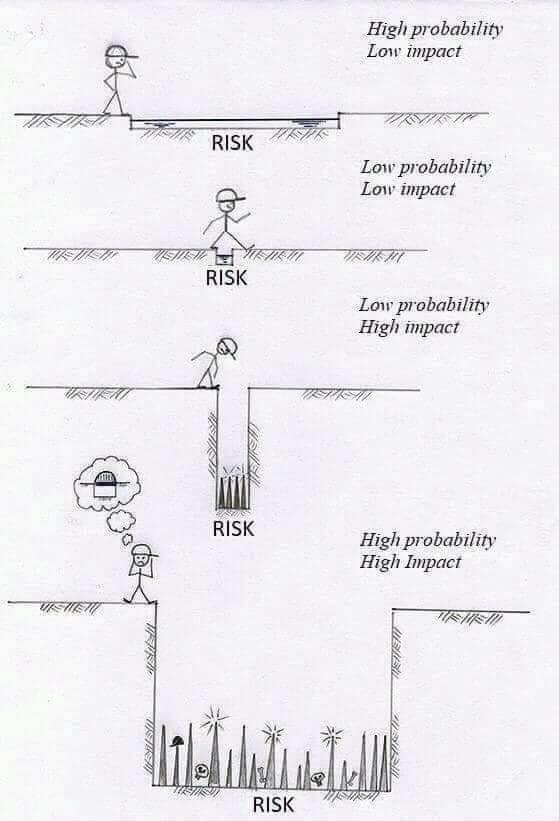Let’s say you take the leap and talk to management about technical debt in your codebase and the need to pay it down. One of two things can happen: you get a “Yes, go ahead and tackle this” or you get the dreaded “No, not right now”. This article is my advice for how to handle the dreaded “No”.
It involves looking at technical debt as risks.
Understanding the “No”
First of all, I’m assuming you did your work and prioritized and analyzed the technical debt that affects your code before asking for time to pay down the most egregious debt.
If you did and you were still told “no” or “not right now”, it’s likely not because management didn’t trust you or didn’t think it wasn’t a concern, but more likely one or more of the following:
- Urgent priorities have to be accomplished first before more strategic work can be considered
- Management didn’t fully understand the risk or ongoing costs associated with existing technical debt
- Management didn’t trust the time and resource impact estimates provided to them on the effort
- Management didn’t believe that the work could be done without introducing defects to users / stakeholders
The fear many seasoned developers have when they hear “we have too many urgent things to spend time paying down debt” is that they’ll keep hearing the same refrain for the next six months or longer.
This is a legitimate concern, and I think part of this stems from the fact that technical debt primarily hurts the development team, but its effects spill out and indirectly hurt users, external stakeholders, and management. These ancillary effects are not often understood to stem from technical debt and that’s something we need to fix.
Management and Technical Debt
Another reason that technical debt doesn’t get prioritized is because it’s not well understood by management and therefore not at the forefront of their mind in the prioritization process.
This isn’t to say that management is heartless and doesn’t care about technical debt. What I’m saying is that technical debt is not what keeps them up at night.
I’m generalizing, I know, but my view is that when non-technical management thinks about technical debt, it’s often as a way of “keeping developers happy” and “doing things that a responsible business person in technology should do”.
These are good reasons to pay down technical debt, but when schedules get tight, these reasons will always be less important than finishing work to meet critical business objectives.
And this is where “No” and “Not now” responses to paying down tech debt come from.
Business managers are often extremely hardworking individuals in a world that is completely different than that a developer, tester, or development manager lives in.
That means they don’t understand the technology the way we do.
Management and Risk
Let me tell you what non-technical management does understand and care about: Risk.
Managers think about various types of risk all the time. Think about the following risks:
- Customer retention numbers being lower than expected
- The deal we’re working on falls through
- Key employees leave us
- A competitor unleashes a new capability that we don’t have
- A startup challenges us in a way the revolutionizes our industry
- A key competitive edge disappears
- A key project is late, impacting other parties or breaching a contract
- A new product is a flop
These are all significant risks that managers need to think about.
We can rephrase tech debt items as risks fairly easily, typically (and if we can’t, are these items really important or are they more of stylistic preferences?). Let’s take a look at some examples of technical debt stated as risks:
- We could fix a bug in 3 places but miss the 4th due to code duplication
- Weaknesses in the design of the current system could lead to slow user experiences at higher scales of usage
- Inadequate security practices could result in breaches and legal liabilities
- We could easily introduce new defects into the application due to our lack of unit tests
- Onboarding new team members could take much longer given the complexity of the codebase
- We could hit a point of terminal velocity where we are unable to implement features in an amount of time the business feels is reasonable because technical debt is slowing down development efforts
- The lack of flexibility and extensibility of the code can lead to us saying no to feature requests that we would otherwise want to implement
I don’t know about you, but these examples of technical debt smell a lot like risks to me.
Additionally, when you can simplify technical details and remove jargon, things get a lot easier for business stakeholders to understand.
Clearly, the business needs to understand the high level risks we deal with as a technology team, because ignoring them is the equivalent of driving a car and treating refilling the gas tank as technical debt – if you ignore it, you’re eventually going to be stranded somewhere short of your destination.
Starting a Risk Management Meeting
What I propose is that development leadership needs to partner with business management stakeholders and invite them into the development organization.
Specifically, I advocate for holding monthly or quarterly risk management meetings in which business and development stakeholders gather to review a list of technical debt risks development has prepared.
The goal of this meeting is to make sure management is aware of new and existing risks, to discuss how these items have affected the team since the last meeting, and to talk about the relative priority and importance of each one of them.
This meeting should take somewhere between 30 and 60 minutes though it may take a little longer the first time.
In it, your agenda should be something like the following:
1. Go over the Risk Register (see next section for details)
- Highlight any new Risks that were not being tracked last meeting
- Highlight any risks that have changed in priority (severity or impact)
- Highlight any risks that have been closed out
- Highlight any risks that had tangible impacts since the last meeting
2. Discuss any new context either side needs to be aware of (e.g. new technology releases, changing project priorities, etc.)
3. Development will give recommendations on what risks should be prioritized in the product backlog
4. After the Meeting: Business should inform development of any changes made to the product backlog, or explicitly inform them that all priorities are remaining the same.
Your goal is not to get technical debt moved to the top of the priority. Instead what you are after is:
- Establishing a relationship of trust, respect, and openness between technical and business leadership
- Helping business management understand obstacles to success and the highest risk factors development deals with
- Helping development leadership understand key business constraints and needs
- Tracking the impact of technical debt on an ongoing basis
- Ensuring that technical debt is prioritized appropriately
This last point is key. At its core, what we really want is that the business has all of the information it needs to make important strategic decisions around its development portfolio and that development leadership is equipped to help individual contributors understand the constraints the business faces.
Tracking the Impact of Technical Debt
I mentioned earlier how we should be tracking the impact of technical debt over time as part of these meetings.
This is where engineering leadership needs to do some heavy lifting.
While some software tools exist to identify and track code smells as likely sources of technical debt, no tool will ever be able to tell you how much time one of your developers lost last week due to a particular instance of technical debt.
This means that tracking technical debt is a human problem and it needs a human solution.
In order to track technical debt, you need to get the people it impacts the most, the developers, to track the way it impacts them in a reliable and repeatable way.
This is a subject I’m still exploring solutions for, but my best ideas center around:
- Tagging time entries in time management systems with a Tech Debt tag and a comment linking back to an item on the risk register
- Adding a custom field to your work item management tool to track the amount of time has been lost to each type of technical debt
- Developers E-Mailing development leadership once a week with estimates of time lost to specific technical debt incidents
- When defects arise as a result of technical debt, link those items to the technical debt item that helped make them possible
None of these answers are perfect, but you’re looking for a reliable low-accuracy way of seeing how technical debt is impacting you over time, these are all things to consider.
Once business is able to see the way that technical debt is hindering the organization, it will start prioritizing and targeting the most dangerous pieces of technical debt, which is what you’re after to begin with.
Closing Thoughts
I do want to stress here that the desire to get business management involved in managing technical risks should never be seen as a ploy or Trojan horse. This should be a sincere and humble effort to help the business understand more of the dangers you are concerned with as technical leaders and a way of building respect, trust, and an open and honest partnership.
Put simply, this won’t happen if you are only looking for a “Yes”. You have to be willing to hear a “No” or “Not now” and understand it, and adjust your priorities to what is truly best for the business while helping them understand and prioritize the things they don’t see.
If we can do this as technical leaders everyone will benefit.
Original article : https://killalldefects.com/2019/12/24/technical-debt-as-risks/

